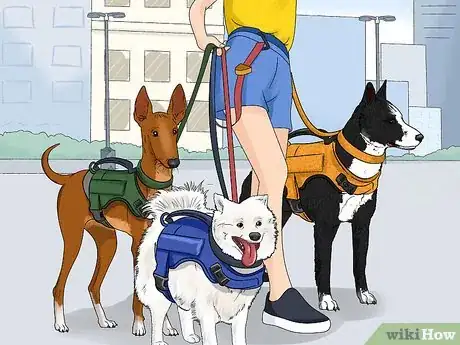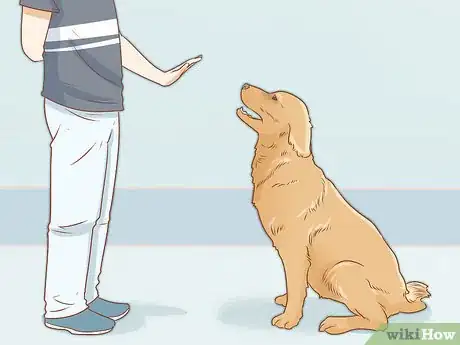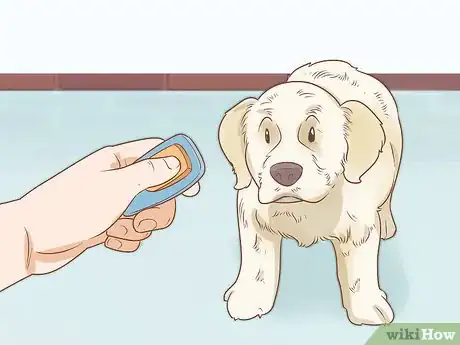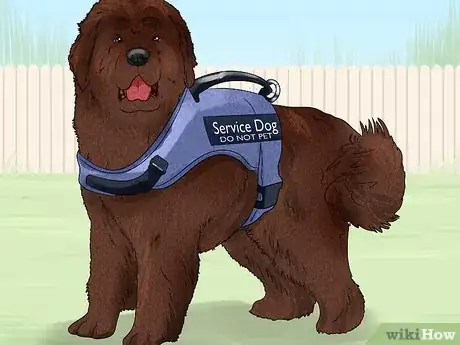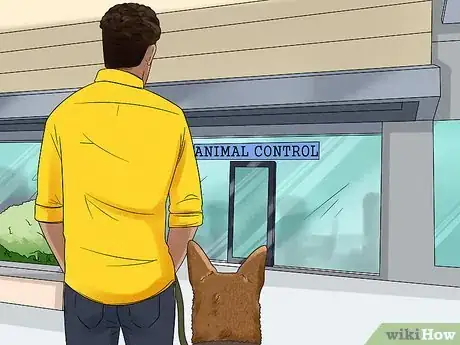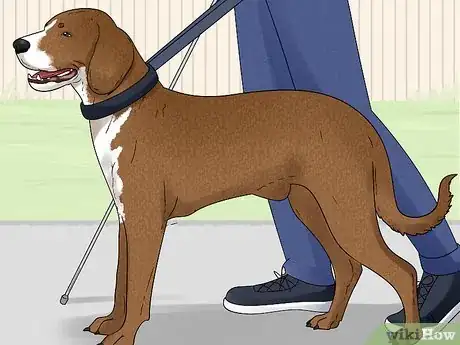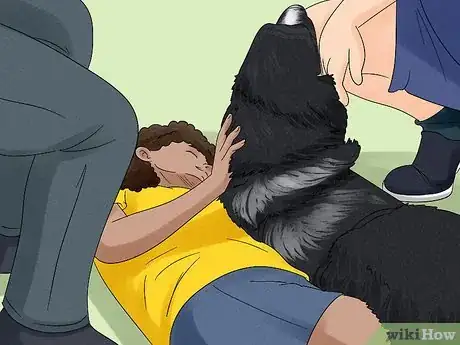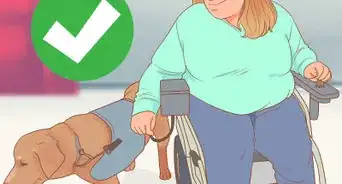This article was co-authored by Beverly Ulbrich and by wikiHow staff writer, Jennifer Mueller, JD. Beverly Ulbrich is a Dog Behaviorist and Trainer and the Founder of The Pooch Coach, a private dog training business based in the San Francisco Bay Area. She is a Certified CGC (Canine Good Citizen) Evaluator by the American Kennel Club and has served on the Board of Directors for the American Humane Association and Rocket Dog Rescue. She has been voted the best private dog trainer in the San Francisco Bay Area 4 times by SF Chronicle and by Bay Woof, and she has won 4 "Top Dog Blog" awards. She has also been featured on TV as a dog behavior expert. Beverly has over 18 years of dog behavior training experience and specializes in dog aggression and anxiety training. She has a Master of Business Administration from Santa Clara University and a BS from Rutgers University.
There are 9 references cited in this article, which can be found at the bottom of the page.
wikiHow marks an article as reader-approved once it receives enough positive feedback. This article has 34 testimonials from our readers, earning it our reader-approved status.
This article has been viewed 657,056 times.
If you have a mental or physical disability, a service dog can help you better navigate and participate in the world around you. A professionally trained service dog is typically the best way to go, but it isn't a requirement! You can absolutely train a dog to be your service dog as long as you have the time and patience for it. Here, we've gathered some of your most common questions about how to train your service dog on your own without a professional trainer.
Steps
Expert Q&A
Did you know you can get premium answers for this article?
Unlock premium answers by supporting wikiHow
-
QuestionWho trains service dogs?
 Pippa Elliott, MRCVSDr. Elliott, BVMS, MRCVS is a veterinarian with over 30 years of experience in veterinary surgery and companion animal practice. She graduated from the University of Glasgow in 1987 with a degree in veterinary medicine and surgery. She has worked at the same animal clinic in her hometown for over 20 years.
Pippa Elliott, MRCVSDr. Elliott, BVMS, MRCVS is a veterinarian with over 30 years of experience in veterinary surgery and companion animal practice. She graduated from the University of Glasgow in 1987 with a degree in veterinary medicine and surgery. She has worked at the same animal clinic in her hometown for over 20 years.
Veterinarian This depends on the nature of the disability the dog is being trained to support. For example, people with sight issues should contact the Guide Dogs for the Blind organization, who run programs to spot talented puppies with the potential to be service dogs. Other organizations linked to specific disabilities can put you in touch with trainers registered with the specific skills to train a support dog. Alternatively, professional bodies such as the Association of Pet Dog Trainers provide links to useful resources that may be of help.
This depends on the nature of the disability the dog is being trained to support. For example, people with sight issues should contact the Guide Dogs for the Blind organization, who run programs to spot talented puppies with the potential to be service dogs. Other organizations linked to specific disabilities can put you in touch with trainers registered with the specific skills to train a support dog. Alternatively, professional bodies such as the Association of Pet Dog Trainers provide links to useful resources that may be of help. -
QuestionHow do I train my dog to go get help if I fall down outside?
 Pippa Elliott, MRCVSDr. Elliott, BVMS, MRCVS is a veterinarian with over 30 years of experience in veterinary surgery and companion animal practice. She graduated from the University of Glasgow in 1987 with a degree in veterinary medicine and surgery. She has worked at the same animal clinic in her hometown for over 20 years.
Pippa Elliott, MRCVSDr. Elliott, BVMS, MRCVS is a veterinarian with over 30 years of experience in veterinary surgery and companion animal practice. She graduated from the University of Glasgow in 1987 with a degree in veterinary medicine and surgery. She has worked at the same animal clinic in her hometown for over 20 years.
Veterinarian Break the task down into small elements and train the dog to do one part, then once he has firmly grasped that move onto the next element. For example, decide on the sequence of events which in this case might be: You fall down, the dog barks to draw attention. First, teach the dog to bark on demand. Then teach the dog to bark with you fall.
Break the task down into small elements and train the dog to do one part, then once he has firmly grasped that move onto the next element. For example, decide on the sequence of events which in this case might be: You fall down, the dog barks to draw attention. First, teach the dog to bark on demand. Then teach the dog to bark with you fall. -
QuestionAs an autistic adult I cannot find any (Canadian) service dog training body to work with me. How do I train a dog to keep me calm in places I cannot be calm enough to train a dog in?
 wikiHow Staff EditorThis answer was written by one of our trained team of researchers who validated it for accuracy and comprehensiveness.
wikiHow Staff EditorThis answer was written by one of our trained team of researchers who validated it for accuracy and comprehensiveness.
Staff Answer wikiHow Staff EditorStaff AnswerTrain your dog to recognize signs that you're becoming anxious and perform some task that calms you. This may mean simulating behavior so your dog learns the signs. You might also want to enlist a trusted friend or relative to take your dog to some of those public places you have a hard time with. Your dog needs public access training before it can effectively help you.
wikiHow Staff EditorStaff AnswerTrain your dog to recognize signs that you're becoming anxious and perform some task that calms you. This may mean simulating behavior so your dog learns the signs. You might also want to enlist a trusted friend or relative to take your dog to some of those public places you have a hard time with. Your dog needs public access training before it can effectively help you.
Warnings
- This article is based on US disability laws about service animals. The law in other countries might differ. Talk to a local lawyer who specializes in disability law for more information.⧼thumbs_response⧽
- Emotional support animals provide comfort but are not trained to perform specific tasks for a person with a disability. As such, they do not qualify as service dogs and aren't guaranteed access to public places under the law.[21]⧼thumbs_response⧽
References
- ↑ https://medicalmutts.org/train-your-own-service-dog/what-is-involved-with-training-my-own-service-dog/
- ↑ https://waservicedog.org/resources/beginners-guide-to-service-dogs/
- ↑ https://www.ada.gov/regs2010/service_animal_qa.html
- ↑ https://anythingpawsable.com/first-five-skills-service-dog-in-training/
- ↑ https://www.newmobility.com/2006/12/training-your-own-service-dog/
- ↑ https://www.newmobility.com/2006/12/training-your-own-service-dog/
- ↑ https://anythingpawsable.com/first-five-skills-service-dog-in-training/
- ↑ https://adata.org/service-animal-resource-hub/misconceptions
- ↑ https://www.akc.org/expert-advice/training/service-dog-training-101/
- ↑ https://waservicedog.org/resources/beginners-guide-to-service-dogs/
- ↑ https://waservicedog.org/resources/beginners-guide-to-service-dogs/
- ↑ https://www.newmobility.com/2006/12/training-your-own-service-dog/
- ↑ https://www.frontiersin.org/articles/10.3389/fvets.2019.00334/full#
- ↑ https://www.ada.gov/regs2010/service_animal_qa.html
- ↑ https://www.akc.org/expert-advice/training/service-dog-training-101/
- ↑ https://www.akc.org/expert-advice/training/service-dog-training-101/
- ↑ https://www.ada.gov/ada_intro.htm
- ↑ https://www.ada.gov/regs2010/service_animal_qa.html
- ↑ https://adata.org/service-animal-resource-hub/misconceptions
- ↑ https://adata.org/service-animal-resource-hub/misconceptions
- ↑ https://www.akc.org/expert-advice/training/service-dog-training-101/
About This Article
While it's not possible to fully train your service dog without a professional trainer, you can train it to perform certain tasks like picking up your keys or alerting you to the phone ringing. For example, start by placing your keys on the floor where your dog can clearly see them. When it approaches the keys, say “keys” and give your dog a treat. Once your dog associates the keys with you saying the word, teach it to hold the keys by using the cue word "Hold" and rewarding your dog when it holds the keys in its mouth. To learn how to have your dog certified as a service dog, read on!
